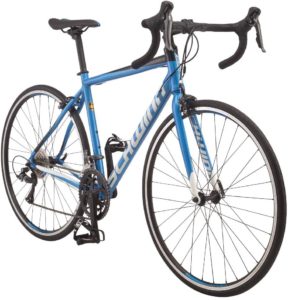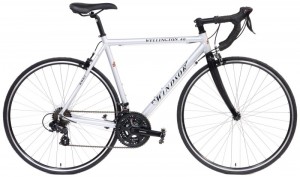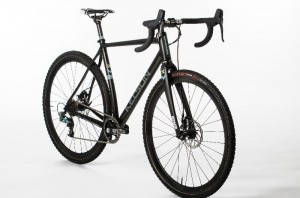Steel, aluminum, titanium or carbon? Which road bike to choose?
 Sometimes it is not easy to choose a new bike. You can be guided by prices, technical specifications, brand, and so on and so forth… And what role does the material of the frame play?
Sometimes it is not easy to choose a new bike. You can be guided by prices, technical specifications, brand, and so on and so forth… And what role does the material of the frame play?
This article discusses what the main differences of the four most popular materials. Most often for the frames of highway trucks goes steel, aluminum, titanium and carbon fiber (carbon).
Sometimes the choice of material is as important as the list of equipment and price tag, each material has its own task. The frame accounts for quite a bit of the total cost, so it’s worth considering which one to prefer.
Aluminium
 Aluminium, or rather aluminium alloys, is the most common material and is used mainly for inexpensive road bikes. Aluminum makes lightweight and rigid frames.
Aluminium, or rather aluminium alloys, is the most common material and is used mainly for inexpensive road bikes. Aluminum makes lightweight and rigid frames.
For a very long time, the disadvantages of aluminum included uncomfortable riding – aluminum frame well transmits shocks to the cyclist. But now there are aluminum frames that allow the bike to roll quite smoothly due to their design.
Most major brands use aluminum frames in entry-level bicycles. But there are premium aluminum options available as well. For example, the ultralight Kinesis Aethein (pictured below) or the new Specialized Allez.
Read also:
Types Road Bikes and How To Choose The Best One
Best Road Bikes Under 1000 – Reviews And Ultimate Buyer’s Guide
There is a renewed interest in aluminum. Some companies are making impressively light frames from it, in which high performance is combined with a relatively affordable price – the Cannondale CAAD12 is an example.
Aluminum is hard to beat in terms of price/quality. Aluminum is the right choice if you’re on a tight budget, need a lightweight and stiff frame for racing, or want the best performance for your money.
Steel
 Steel used to be the only material that you could choose from. Steel is very resilient and has excellent vibration dampening, so it is quite pleasant to ride a steel bike, not without reason that long distance riders: touring cyclists and audax bikers appreciate them.
Steel used to be the only material that you could choose from. Steel is very resilient and has excellent vibration dampening, so it is quite pleasant to ride a steel bike, not without reason that long distance riders: touring cyclists and audax bikers appreciate them.
Lately, steel bikes have even been used for racing, as Madison-Genesis proved a couple of years ago with the Volare 953.
Major manufacturers don’t make steel bikes now, but because of the ease of machining, steel is preferred for custom frames. Manufacturers of quality steel tubes, such as Italy’s Columbus and Britain’s Reynolds, fortunately have not only not given up on steel, but have invested in developing new sets of tubes. Their newest stainless steel solutions are now lighter and tougher than ever, and can be an alternative to carbon fiber and aluminum.
Steel is suitable when you want a custom frame or smooth ride is the main requirement and the weight of the bike doesn’t matter much.
Titanium
Titanium is great for riding, combining the lightness of aluminum with the strength of steel and its ability to dampen vibration. It is also corrosion-resistant and can be polished rather than painted, so a titanium frame will last a long time, making up for its high price. Titanium can also be used for racing bikes, but more often it is used for sporty audax bikes and all-purpose bikes, which are suitable for comfortable long-distance riding, with or without luggage.
One such bike, the Sabbath September, is pictured below: Most titanium frames go with 3AL-2.5V (titanium alloyed with 3% aluminum and 2.5% vanadium), while 6Al-4V, a harder grade of titanium, is used in expensive frames. Since it is difficult and expensive to make seamless tubes from 6Al-4V, it is often used for machine-machined parts such as dropouts and head tubes. Titanium is fine if you want a bike that lasts long, is lightweight, and has a smooth ride.
Carbon
 Carbon is the top choice in the cycling world and is the lightest and stiffest of the four materials, though less durable than the others. And it is usually the most expensive of all.
Carbon is the top choice in the cycling world and is the lightest and stiffest of the four materials, though less durable than the others. And it is usually the most expensive of all.
In recent years, its prices have fallen. We should also take into account that carbon does not bear any loads if their direction does not coincide with the direction of its fibers.
It is the most pliable of materials, so designers and constructors can get creative. Aerodynamic road bikes are a measure of the material’s flexibility, such as this Trek Madone. A carbon frame is not a carbon frame, of course.
The cost and type of fiber used and how it is made greatly affect quality. Designers can relatively easily create interestingly shaped frames out of carbon, with the set of features they want, be it low weight, comfort, stiffness… If you want the lightest and stiffest roadster you can find, and it shows its true colors when you accelerate, carbon is the right choice.
The Takeaway
The market has a great selection of bikes made from all four materials, allowing you to choose according to your needs and budget.
Steel is the traditional choice for most riders, offering a balance of strength, comfort, and affordability. Titanium is strong and light like steel but with added vibration damping properties, making it a great choice for long-distance rides. Carbon fiber is the lightest and stiffest option but also the most expensive. Aluminum is lighter than steel but not as strong or comfortable, making it the best choice for racing bikes.
So there you have it – a brief overview of the four most common materials used in bike construction. Now you can make an informed decision when buying your next bike!